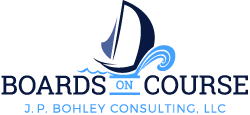Tip #50 How to Manage Board Disagreements Proactively and Constructively
In this Tip for Effective Boards, we’ll continue our discussion of the 4th P for Building Your Board Team: Manage Your Board Group Process Effectively and we’ll focus on tips for managing board disagreements proactively and constructively.
Prevent Unnecessary Unproductive Disagreements. Prevent such disagreements by clarifying roles, relationships, and expectations of board members, chair, CEO and staff. Be sure that it is clear what authority is being delegated by the board to the CEO and what authority is being reserved by the board to itself. (The Policy Governance® model provides a comprehensive board governance design with a clarity that prevents such unnecessary unproductive disagreements. For information about the Policy Governance® model, please click https://www.BoardsOnCourse.com/policy-governance.)
Encourage Healthy Productive Disagreements. Establish board meeting “ground rules” that clearly express expectations about everyone’s participation, encouragement of differing perspectives, and respectful reactions to such perspectives. Encourage an openness to learning from others. Such openness involves recognizing one’s own limitations in terms of knowledge and perspectives. To paraphrase the Prayer of St. Francis, let us seek first to understand what others are saying before seeking to be understood by them. Be willing to speak our position and let go of it, not taking opposing viewpoints as criticism or as threats. Think out loud together as a board and develop a shared understanding of different points of view. (For information on “ground rules,” check out Tips for Effective Boards #39: Establish Ground Rules for Effective Board Meetings by clicking https://www.BoardsOnCourse.com/blog.)
Avoid Groupthink. Groupthink occurs when a group’s desire for group harmony and cohesiveness prevents the group from fully considering alternatives. Tips for avoiding Groupthink include the following: recruit board members with diverse backgrounds and experience, encourage everyone’s participation in boardroom discussions, access perspectives and information from outside the boardroom, encourage the expression of differing opinions, welcome differing opinions with respect, explore alternative views, assign one or more board members to articulate contrary views, use a silent vote so that dissenting opinions can be expressed without hesitation, and don’t rush to a decision. FYI. Groupthink is a group process concept developed by Irving Janis, Victims of Groupthink (Boston: Houghton Mifflin, 1972).
As you may remember, in our last several Tips for Effective Boards we have been discussing the 4 P’s for Building Your Board Team: Purpose, People, Plan and Process. With this Tip for Effective Boards we conclude our overview of the 4 P’s. The 4 P’s incorporate insights from the Policy Governance® model developed by John Carver, from other governance writers and from the group dynamics and team-building literature. If you have missed any of the 4 P’s or want to revisit them, please click https://www.BoardsOnCourse.com/blog and check out Tips 42-50.
Please take the time to check out the Policy Governance® model. It provides a comprehensive board governance design that supports and enhances effective group process. For more information about the Policy Governance® model please click https://www.BoardsOnCourse.com/policy-governance or contact me at jpbohley@gmail.com.
I will be happy to customize a workshop for your board on any or all of the 4 P’s or on the Policy Governance® model which provides an excellent governance design for the 4 P’s. If you would like more information, please respond to this email or contact me via jpbohley@gmail.com.
